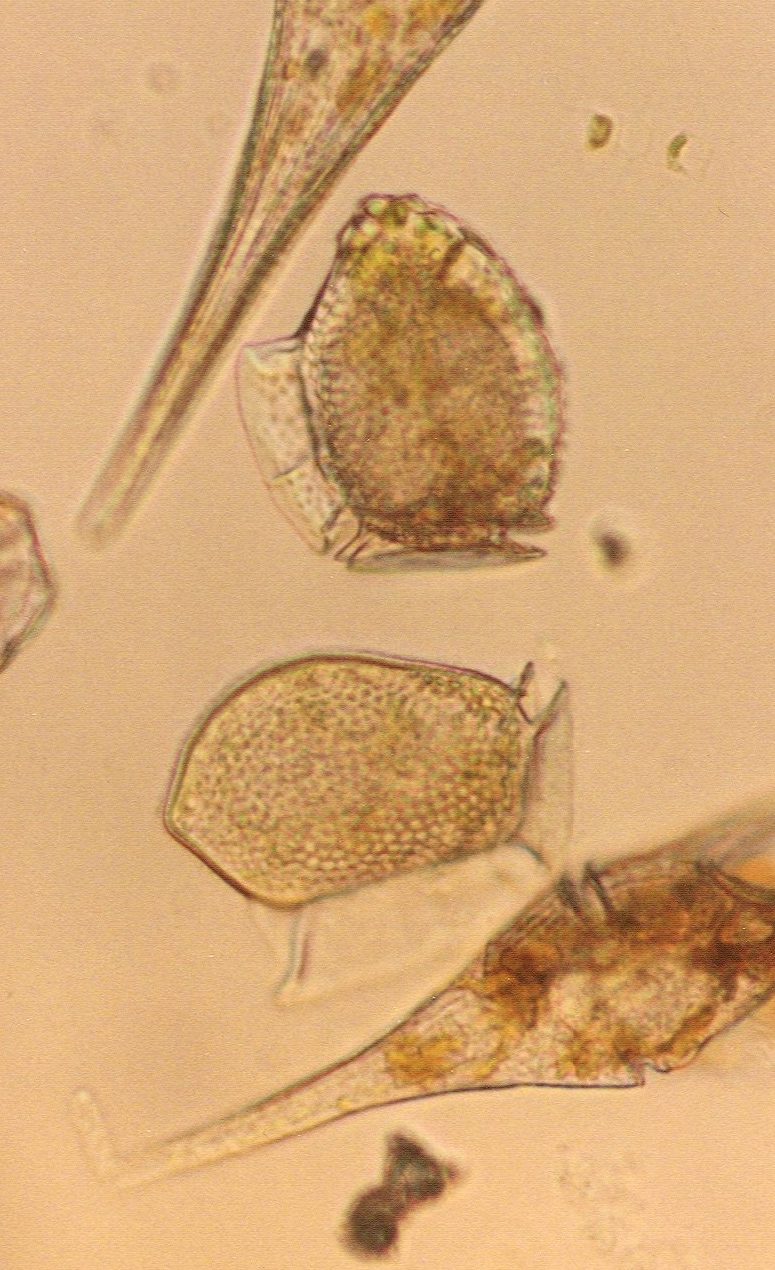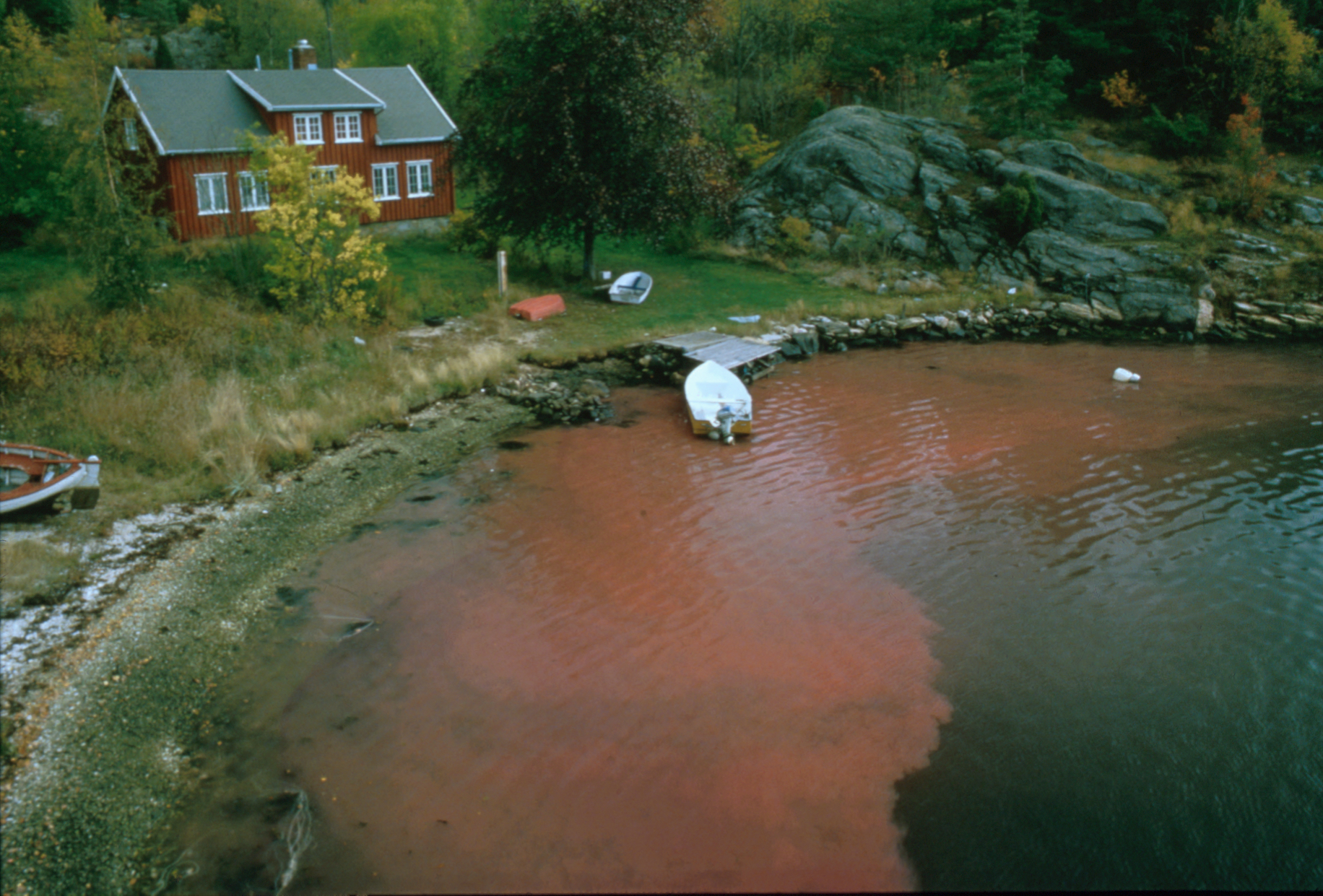
Dinophysis
- Bloom forming genus of dinoflagellates
- More than 100 recognized species
- Produce okadaic acid & dinophysotoxins, which may lead to:
- Human poisoning cases - Diarrhetic Shellfish Poisoning (DSP)
- Shellfish fishery closures
Morphology & Ecology
Dinophysis is a genus of approximately 100 dinoflagellates that are common in tropical and temperate waters worldwide. The genus is able to thrive in water temperatures ranging from the Arctic Circle to the tropics and is clearly established in the Atlantic, Pacific, and Indian basins. The name Dinophysis originates from Greek meaning "terrible nature".
Dinophysis cells can be recognized by their reduced epithecal plates and collar like structure. They are relatively oval with dorsal ventral flattening and are between 35-50 µm long. Some thecal characteristics can be used to recognize separate species within this genus although, each species may have a series of shapes due to their polymorphic life cycle and feeding behavior making species specific identification more challenging. These dinoflagellates are known mixotrophs, meaning they do not rely on autotrophy or heterotrophy alone. They obtain resources partly by preying on another predatory plankton species, Mesodinium, but also performing photosynthesis by integrating the chloroplasts of the prey they consume. Mesodinium feeds on a phototrophic group of plankton, the cryptophytes, which places Dinophysis as the top predator of this three-tiered ecosystem in the water column. Dinophysis itself is consumed by filter-feeders, frequently shellfish.
Even though these species have diverse ways of acquiring energy, they are difficult for scientist to maintain in culture due to their heterotrophic ways. Maintaining a culture of Dinophysis requires the creation of this three-tiered food web, rather than simply adding the required nutrients and appropriate light levels as is done for photosynthetic algal cultures. This makes studying on their populations in the lab more challenging.
Impacts & Toxicity
Around 10 of the species within this genus produce toxins including okadaic acid, pectenotoxin, and dinophysistoxins over the course of their regular life cycle. Okadaic Acid, one of the primary toxins of interest, is a potent inhibitor of protein phosphatase 2A, an integral part of metabolism membrane transport, secretion, and cell division, and is also a first stage tumor promoter. Since these species can produce multiple groups of toxins, understanding how toxicity varies between populations is complex for Dinophysis. Not only is toxin production affected by genetic factors associated with each species of Dinophysis, but is additionally impacted by environmental conditions. This leads to wide variability in proportion, concentration, and toxicity levels within a single species or strain.
The filter-feeders that consume Dinophysis accumulate and concentrate these toxins in their tissues, even when toxic Dinophysis is at low concentrations in the water column. Shellfish contaminated with more toxic Dinophysis cells can cause diarrheic shellfish poisoning (DSP) in humans. DSP is not fatal, but causes severe gastrointestinal distress. Symptoms of DSP include diarrhea, nausea, vomiting, and abdominal pain, beginning between 30 minutes and a few hours after consuming the contaminated shellfish and resolving within three days. Although there are no direct recorded impacts on wildlife, okadaic acid has been detected in deceased marine birds and mammals during large die offs linked to other harmful algae, indicating a potential to compound the impacts of other toxins.
Resources & References
Research Articles
- Jia, Y., Gao, H., Tong, M., & Anderson, D. M. (2019). Cell cycle regulation of the mixotrophic dinoflagellate Dinophysis acuminata: Growth, photosynthetic efficiency and toxin production. Harmful algae, 89, 101672.
- Jiang, H., Kulis, D. M., Brosnahan, M. L., & Anderson, D. M. (2018). Behavioral and mechanistic characteristics of the predator-prey interaction between the dinoflagellate Dinophysis acuminata and the ciliate Mesodinium rubrum. Harmful algae, 77, 43-54.
- Reguera, B., Riobó, P., Rodríguez, F., Díaz, P. A., Pizarro, G., Paz, B., ... & Blanco, J. (2014). Dinophysis toxins: causative organisms, distribution and fate in shellfish. Marine drugs, 12(1), 394-461.
- Reguera, B., Velo-Suárez, L., Raine, R., & Park, M. G. (2012). Harmful Dinophysis species: A review. Harmful Algae, 14, 87-106.
Fact Sheet

Distribution in the U.S.
Dinophysis species are found along both the East and West coast of the United States with major blooms reported in Washington State, the Gulf of Mexico, Long Island Sound, and the northeastern Atlantic Coast (see DSP map). Shellfishing closures for DSP have occurred around the country, previously concentrated on the coast of Washington and the Gulf of Mexico, including Alabama and Texas, and more recently in New England.

